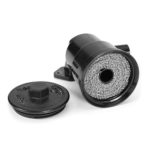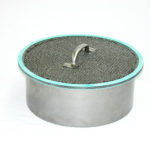Engineered Filters Separators I Metal Textiles
Filtration
Filtering liquids, air or gas in hostile environments—such as those subject to temperature extremes, high orders of shock/vibration, and caustic fuels or fumes—has posed problems for paper filter elements. Such elements simply will not withstand these types of operating conditions for very long. Filters separators are essential.
Paper or sintered metal filter elements are satisfactory for most applications. But where the filter must handle hot, corrosive or caustic fluids, or where the equipment is subjected to shock and vibration, conventional elements may dissolve or disintegrate. In such applications, a knitted wire high temperature filter and/or high pressure filter may be the only solution that can provide the required life.
Metal Textiles high temperature filters provide an economical, robust alternative. From cryogenic operating conditions up to temperatures of 650° C, knitted wire mesh filters maintain their integrity even when subjected to extremely high vibration and exposed to destructive gases such H2, SO4, and HNO3.
Filter Separator Efficiency
Even when compressed to extremely light densities (or where pore size is larger than the particle size of the contaminant), Metal Textiles filters achieve efficient filtration and small contaminate particles are efficiently removed from the fluid stream. In addition, the tortuous path construction results in greater retention, without blockage, than can be expected from other filter media. Knitted mesh filters are resilient enough to fit (or retrofit) into filter cavities of virtually any configuration and still retain a secure friction fit.
Filter Separators Product Benefits
- Resistant to high temperatures up to 650°C
- Immune to mechanical stress
- Impervious to chemical corrosion
- Withstands extreme thermal shock
- Resilient—permitting tight fit to a given filter cavity without machining to critical tolerances
- Can be supplied in virtually any geometry
- High efficiency & low pressure drop
- Available in a wide variety of alloys
- Competitively priced
- Minimal tooling costs
Liquid Filtration
Metal Textiles knitted wire mesh may be used for liquid filtration and/or separation in the following industries:
- Chemical processing
- Gas turbines
- Food processing
- Water and waste treatment
- Pharmaceuticals
- Plastics
- Brewing and winemaking
- Gasoline, diesel or alternate fuel engines
Air Filtration
Metal Textiles knitted wire mesh filters are used in the following applications:
- Engine crankcase—breather elements
- Air conditioning systems—to filter compressor oil from air and to remove pollen from intake air
- Restaurant range hoods—as grease traps
- Heating and ventilating systems—to filter dust
- Intake filters—for air compressors
- Clean air rooms—as dust traps
- Engine air intake filters
- Industrial vacuum cleaner filters
- Air cleaning and smog suppressant equipment
- Washing machines—as lint traps
Separators
For peak output performance from a compressor, blower, engine, or vacuum pump, air must be able to flow unrestricted. Selection of the proper media must be considered as it impacts the air velocity, and hence, the operating condition of the equipment. Metal Textiles designed and manufactured knitted wire mesh compressor breathers and oil separators provide long lasting performance, and high efficiencies in separating liquids from the air and gas stream by means of the three capture mechanisms of separation – impaction, interception and diffusion.
Knitted mesh separators are designed to handle any specific CFM of a compressor and can be made using a broad range of materials, sizes, densities and shapes – allowing immediate changes in key performance criteria to match your process.
 Metal Textiles separators, which are manufactured from knitted wire, have a high surface area and the series of interlocking loops allow excellent flexibility and structural support. In addition, wire mesh provides the lowest-cost solution—especially when installed inside compressors that are sized for other process considerations.
Metal Textiles separators, which are manufactured from knitted wire, have a high surface area and the series of interlocking loops allow excellent flexibility and structural support. In addition, wire mesh provides the lowest-cost solution—especially when installed inside compressors that are sized for other process considerations.
To ensure maximum performance and to prevent flooding, we recommend that the housing or cavity into which the separator is installed be properly reviewed, as it is an integral part of the overall design. Otherwise, the separator itself will be compromised and the system will not function properly. Metal Textiles offers complete one-source support for both compressor breather element and housing design and production.
Metal Textiles products allow the liquids to be separated while permitting the air or gas to pass through the separator and into the equipment. The liquids are then drained and removed by the return lines, and then re-compressed in a continuous cycle.
Product Benefits
- Long service life
- Cost effective-can withstand temperatures between -45C to 650C depending upon material selection
- High separation efficiencies
- Easy to install in existing or new housing spaces
- Can vary element density and surface area to solve the most difficult separations problems
- Reduction in noise due to high mechanical damping characteristics and non- linear spring rates of knitted materials
Metal Textiles designs are based on, among other design principles, the Souders-Brown correlation factor. This factor measures the point at which the separator will flood based on a specific load-point velocity through the separator. The Metal Textiles separator is then designed at 80% of the maximum flooding velocity to ensure maximum efficiency over the life-time of the engine.
When specifying a separator for your application, other factors that need to be considered are:
- Particle size distribution
- Compressor volume in CFM, CFH or liters per minute
- The pressure drop that can be tolerated
- Cost of the separator
- Whether the separator will be installed inside existing equipment or if a stand-alone vessel is required
- Liquid handling capability of the separator
- Material availability, compatibility with the process
Engine Crankcase Breathers
Four decades of experience in designing and manufacturing crankcase-emission filtration systems have made Metal Textiles the supplier of choice for all types of consumer- and commercial-vehicle applications, both on- and off-highway.
Metal Textiles designed and manufactured engine crankcase breathers provide long-lasting performance in reducing crankcase emissions as well as oil consumption and oil pooling on external engine and vehicle parts—while protecting air-intake products in closed-crankcase ventilation (CCV) systems.
External crankcase filtration systems consist of a breather assembly or mechanical device secured directly on the engine or by remote bracket-mounting. Unlike other systems, Metal Textiles Breather Elements and Assemblies are designed to remove both fine and coarse particles, as well as fine oil-mist condensation.
Open Crankcase
In open-crankcase ventilation systems Metal Textiles helps reduce engine oil consumption, the threat of catastrophic engine failure due to oil loss in engines in remote locations, and invalid warranty claims due to deposition of oil on engine and other vehicle parts. They also help eliminate accumulation of oil mist on test-cell equipment.
Closed Crankcase
In closed-crankcase systems, specifying the right Metal Textiles Breather Element or Assembly can help reduce warranty service levels due to pooling of lubrication oil in the crankcase pressure control valve, as well as turbocharger intake compressor and intercooler. Metal Textiles custom products also reduce the formation of an oil film within the heat exchanger or the after-cooler or intercoolers on certain turbo-charged engines.
Benefits
- Long service life—four times more durable than competing products
- Can withstand temperatures between -45°C to 650°C, depending upon material selection
- High separation efficiencies of 95-99% with low pressure drop
- Can vary element density and surface area to solve the most difficult separation problems
- Can accommodate any available engine space
- Easy to install in existing or new cavities or housings
- Ability to combine monofilament or multifilament material into one breather element
- Better, more cost-effective solutions for reducing crankcase emissions
Reduced Crankcase Emissions & OEM Costs
Metal Textiles has the material-science knowledge, as well as design-engineering and manufacturing expertise, to supply breather elements and assemblies in any size and for any type of engine—with blow-by levels ranging from 0.2-40 cubic feet per minute.
In-house Testing Capabilities and Equipment
Metal Textiles uses the very latest test equipment and procedures to optimize the design of each Breather Element and Assembly. Variables such as flow rate, temperatures and pressure drop can all be measured and controlled in our custom-designed laboratory.







Recent Comments